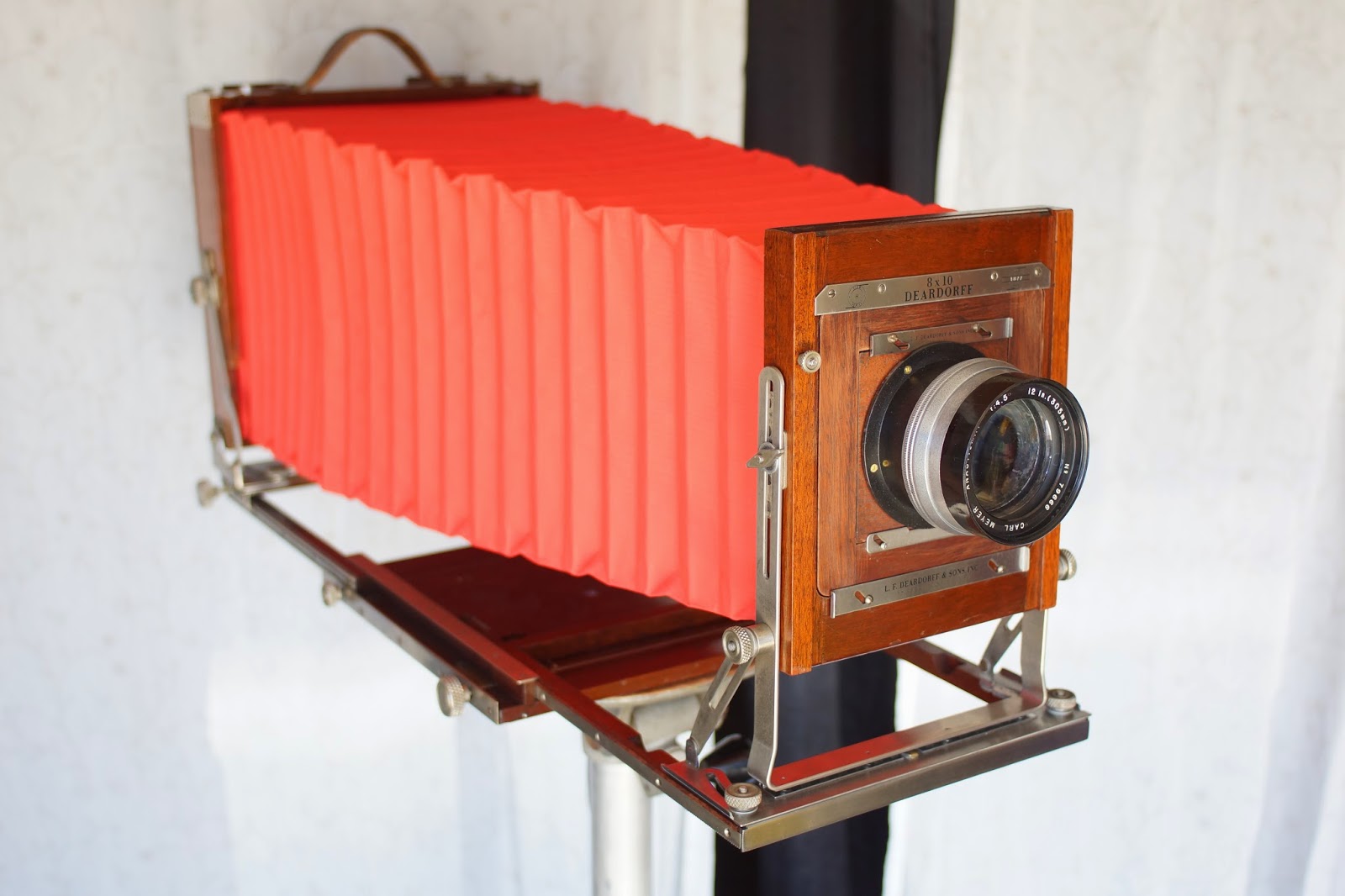Wet plate photographers have many choices, when it comes to lenses. You can choose from all the newer, modern multicoated lenses, corrected apochromatic, rectilinear. It goes on and on. Large format lenses with iris and compound shutters, or vintage 100 year old brass lenses without aperture control or shutter.
I like used lenses because you can get some great deals on fabulous high quality optics - new lenses can be very expensive. I love finding old quirky lenses with that "je ne sais quoi" optical quality. They produce photos with that unmistakable uncoated, crapy low contrast, mediocre vintage look. Just kidding. You'd be surprised how some vintage lenses surpass modern lenses in creating memorable images. It is all subjective. You'd also be surprised to find that some of the old brass lenses are fetching well over a thousand dollars because of renewed interest in wet plate photography.
Below is a Deardorff 8x10 field camera with a vintage Carl Meyer 305mm f/4.5 with an iris but absent a shutter. It's a large lens with almost 3 1/2" diameter. How do you control time exposure without a shutter?
 |
| My Deardorff V8 8x10 with a Carl Meyer 305mm f/4.5 shutter-less lens |
You can always use the lens cap, remove it and replace it for long exposures. Of course, if you need to accurately control the time the plate is exposed to light then you are going to need one of the few shutters available for this type of lens.
 |
| The hose connects to the bottom of the piston. |
Packard shutters are the most common and are sold on eBay regularly. They are pneumatic, or actuated by an air bulb and a hose. They are installed behind the lens board, between lens and camera.
You can get them with sync capabilities which allows you to use flash. You can get them with a pin that permits what they call "instantaneous" mode, which is an exposure of approximately 1/25 of a second. Without the pin you get "Bulb" mode. Squeeze the bulb and it stays open until you let go of the bulb.
These shutters have been around for a long time as seen in the patent document below, but you can still purchase a brand new one from the
Packard Shutter Company.
 |
| Click to see larger |
Back to lenses. Below is a huge 13.5" Wollensak f/3.8 Vitax lens that I mention in another post. This monster Petzval weighs almost six pounds, with a diameter of nearly four inches and a length of nine inches it's hard to feel safe with this thing hanging on the front of your camera, check my other blog posts to see this Vitax mounted on an
Eastman 8x10.
Big glass and heavy brass. It has an iris to control aperture but no shutter. The Vitax Portrait lens has an unusual feature that few lenses have, a soft focus knob. This knob controls the separation of two of the glass elements and softly blurs the image just a wee bit. Apparently these are quite sharp when stopped down. This feature allows the photographer to dial in the "soft focus" for flattering portraits.
 |
| Wollensak 13.5" f/3.8 Vitax Soft Focus Portrait Lens is a Petzval lens. Average price today, over $1000. |
Seems appropriate to delve into Petzval lenses, since they are sought after by many wet plate photographers. Back in the time when Daguerreotypes were the rage. Photography was in it's infancy, and exposures were long, very long. An exposure could take 30 minutes, and if you moved during this time the photo could turn out to be just an ugly blur.

There was a need to create a fast lens to cut down exposure time for photography. In 1840 The Society for the Encouragement of Industry in Paris, offered a prize for this elusive lens and the race among designers of optical instruments was off.
It was
Joseph Petzval, a professor of mathematics at the University of Vienna who would design the lens that would revolutionize photography.
 |
| Petzval revolutionized lens design |
The French Society for the Encouragement of Industry did not give Petzval the first prize, although his lens was much faster than any of the other lenses submitted. Petzval's "second prize" winning lens became the dominant portrait lens for nearly a century, while the "first prize" lens would prove to be a commercial failure.
Lens design was mostly trial and error at the time. The Petzval portrait lens, purported to be the first lens designed using mathematics, would change the science of lens design. Petzval lenses were as much as 20 times faster than the lenses in use at the time.
What attracts modern wet plate photographers to Petzval lenses? They are mostly big brass lenses without shutters and many don't have irises. It's the look. These vintage lenses have a unique look. The center can be focused very sharp while the edges have this incredibly swirly soft
bokeh. It's a look you can't get from a modern lens.
Lens designers have refined and perfected lenses. They make them so they are crispy-focused all the way to the edges. Lens manufacturers are always trying to remove all imperfections, aberrations and distortions out of modern lenses. Ask the
lomography crowd why they like photography with low-tech, no fidelity and crappy optical quality. It's the look!
 |
| Wonderful example of swirly bokeh from a Petzval lens in this picture by Coco Alexander |
Check my eBay listings, you might find something you need:





















































